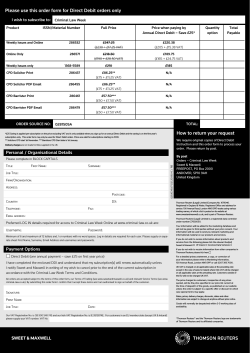
Sole trader and partnership tax • Trading Income • Application to partners
Sole trader and partnership tax • • • • Trading Income Application to partners VAT Stamp Duty Trading Income See Introduction to Tax Ch 5 • Income Tax (Trading and Other Income) Act 2005 • Profits of trade, profession or vocation • Paid by self-employed persons - sole traders and partners Tax paid on the profits of the business • Profit figure taken from the business accounts, • See the profit and loss account pg 20 Profit and loss account • Sales • Less cost of sales • =gross profit • Less expenses • =Net profit 10,000 (6,000) 4,000 (2,500) 1,500 Trading Income • Only receipts of an income nature are subject to income tax ie profits from trade / profession • But, only expenses of an income nature can be deducted • e.g. money spent on stock, heating/lighting premises, insurance payments Expenses • Must be incurred ‘wholly and exclusively’ for the purposes of the trade or profession • Some expenditure excluded by tax Acts, e.g. special rules for cars, pensions etc Capital expenditure and allowances • Capital expenditure is money spent on long term assets, premises, plant and machinery, etc • Not of income nature and so not deductible from profits as an expense. • Some capital items qualify for a capital allowance (also called depreciation) Example of capital allowance • Sole trader spends £10,000 on office furniture (capital asset) • £ spent is not an expense (capital expenditure) • Can claim a capital allowance / depreciation every year on the item • The main rate for capital allowances is 25% every year on the net book value of the asset • Special rate for small & medium sized businesses - 1st year only 50% (small) 40% (medium) Example for a medium sized business • 1st Year – asset purchased for £10,000 – 10,000 x 40% = 4,000 (deductible) – At end yr 1 value is 10,000 - 4,000 = 6,000 • 2nd year – 6,000 x 25% = 1,500 (deductible) – At end yr 2 value is 6,000 – 1,500 = 4,500 • 3rd Year – 4,500 x 25% = 1,125 (deductible) – At end yr 3value is 4,500 – 1,125 = 3,375 Relevance to Income Tax • The capital allowance figure (depreciation) not only used to reduce value of the asset on the balance sheet • It also reduces the profit made in the same year for tax purposes • Eg in yr 1 the business made £50,000 profit • Capital allowance in year 1 was £4,000 so profit reduced to £46,000 Practice Question Capital Allowances • Manisha is a sole trader and her business is classed as ‘small’. • She buys a business asset in year 1 for £83,000. 1) Calculate the net book value at the end of year 1. 2) If her profit (after expenses) in year 1 is £125,000 calculate her taxable profit. Answer • Asset bought for £83,000 • Cap All is 50% (in yr 1) = £41,500 • End of yr 1 net book value = £41,500 • Profit in yr 1 = £125,000 • Deduct Cap All of £41,500 • Taxable profit = £83,500 Income Losses • If the taxpayer makes a loss • (ie expenditure exceeds income) • it can be set off against profits made – on income from other sources that year or – on income from any source in the previous year (one year only) or – on income from same trade only in future years (without time limit) Losses made in early years and final year • Losses made in first four years of a new business can be carried back against income from any source in the three years prior to the loss • A loss made in the last year of the business can be carried back up to three years, but only against the profits of the same trade Basis of assessment • Assessed on the profits for the accounting period ending in the tax year • Taxpayer chooses own accounting period (‘financial year’) • Self assessment tax return sent to HMRC with the accounts and the tax due • Special rules for opening and closing years of business (see p 24) Example • Sole trader’s financial year ends 30th September each year • Tax for 2007 - 08 is based on accounts for period ending September 30th 2007 • Tax return to IR not later than 31st January 2009 • With cheque for tax due Partnerships: income tax • Partners are liable for their own tax on their share of the profits of the firm • Each partner submits a tax return and the firm submits a partnership tax return, with a copy of the partnership accounts • Each partner may have other income, different personal allowances, may choose different form of loss relief, etc. • Partners not liable for each other’s tax liabilities Partnerships: CGT • Partnership sells a capital asset • Each partner liable to CGT on their share of the gain. VAT Chapter 11 p 52 Value Added Tax (VAT) • Tax on supply of goods, services, sometimes land • Supplier has to be registered for VAT (compulsory if turnover is £64,000) • Supplier charges customers VAT • sends VAT collected (output tax) less VAT paid to others (input tax) with quarterly VAT return VAT Rates • • • • Standard rate 17.5% Zero rate 0% Special rate 5% Some supplies exempt Example • Builder supplies £100,000 worth of services • If all charged at 17.5% • Output tax = 100,000 x 17.5% = £17,500 • Builder buys £60,000 worth of goods • If all charged at 17.5% • Input tax = 60,000 x 17.5% = £10,500 • Builder pays 17,500 - 10,500 = £7,000 VAT Registration • Compulsory if turnover is £64,000 • Voluntary registration may be beneficial if: – most supplies are zero rated or exempt, or – useful to register when set up business then de-register • Allows VAT paid out to be reclaimed (otherwise not possible) Solicitors’ Disbursements • A disbursement is money paid out on behalf of a customer on their instructions • Examples are stamp duty and search costs incurred when conveyancing • These may be excluded from the VAT account so that VAT does not have to be charged to the client Stamp duty Chapter 12 p 54 Stamp Duty • Historically a tax on documents • Document had to be stamped to show the tax has been paid • Paid by purchaser • System recently changed with intro of Stamp Duty Land Tax (SDLT) Shares and other securities Calculated as a percentage of the value Transfers of shares, etc. 0.5% – Round up the tax to the nearest £5.00 – Not payable on gifts Time limit • Document must be stamped within 30 days after execution • Financial penalties for late stamping SDLT • Duty payable on all UK property transactions – freehold and leasehold • See handbook for basic details Next lecture • Corporation tax • See chp 10 tax handbook
© Copyright 2025





















